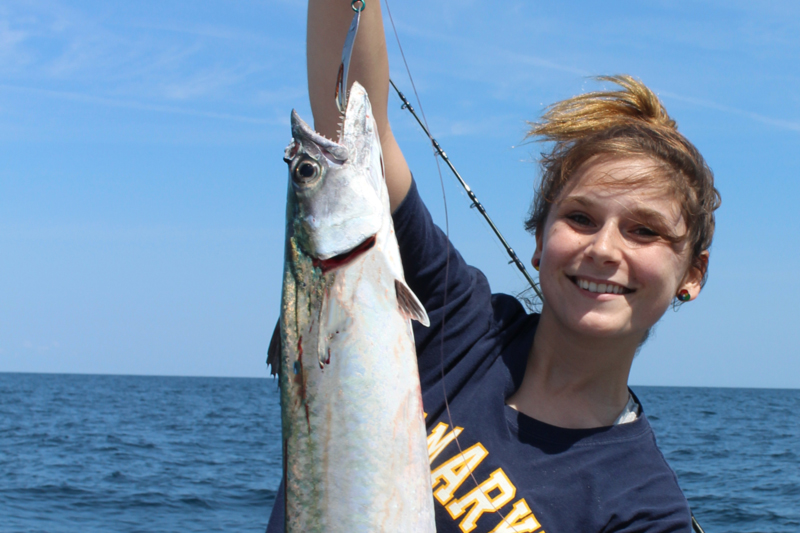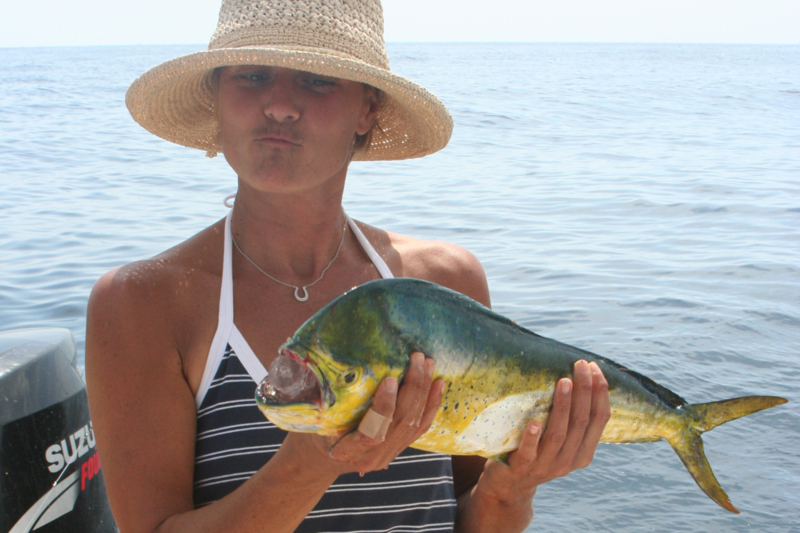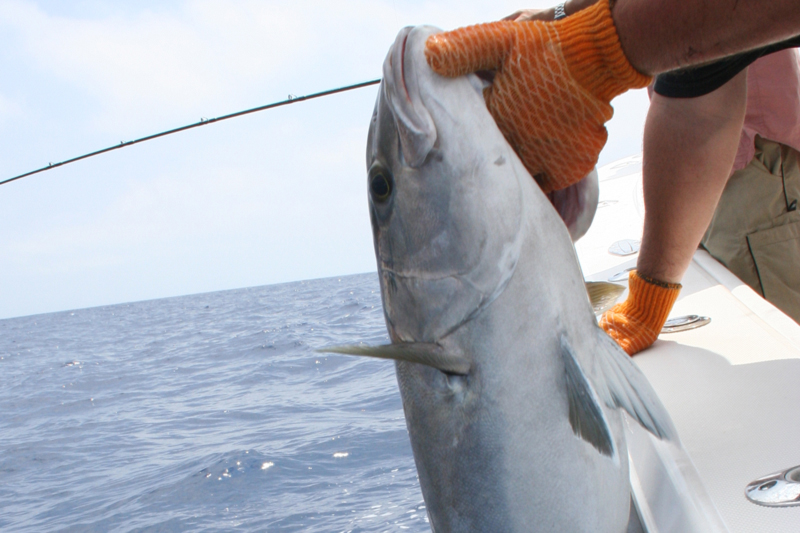Trolling for yellowfin probably won't be in the cards if rough seas are in the offshore forecast, or maybe your boat isn’t very big, or maybe your time is limited, or maybe you’re just not comfortable with the thought of making a 60- or 70-mile run. Whatever the reason may be, most anglers who plan to leave the inlet but stay within 20 or 25 miles of shore will opt for bottom fishing for the likes of sea bass and flounder. No harm, no foul — with all the wrecks and reef sites off the Mid-Atlantic coastline, this can make for an awesome day of fishing. But what if you want to do something a little bit different? What if you still want to have a shot at some larger oceanic beasts?

Don’t think for a minute that staying relatively close to home limits your options. Species like mahi-mahi, king mackerel, cobia, bluefish, and at times even bluefin tuna or mako sharks may be a possibility.
Inshore Structure
Whether you’re departing from Indian River, Ocean City, Wachapreague, or Virginia Beach, along most of the Mid-Atlantic coast every time you run for the deep you pass by inshore structure that holds fish. The first important thing to keep in mind about looking for alternate inshore species is that many of those same wrecks, reefs, and shoals that anglers hit when bottom fishing also attract upper-level predators. No, you aren’t likely to encounter the likes of billfish at these spots, most seasons tuna will be a long shot, and the presence of makos varies by the season. Just which species you’ll encounter will depend on the specific location and yearly changes. But regardless of what might be swimming in your neck of the woods, the key to locating fish inshore is usually a matter of locating structure.
Free-swimmers like the aforementioned species might not stick close to structure the same way bottom fish do, but they certainly use it as hunting grounds. This includes not only wreck and reef sites but also significant contour changes like the Jack Spot off Ocean City, or the Hook off Rudee. Fields of bass pot floats are another fish-attracting feature worth some attention in inshore waters, since some seasons they attract and hold schools of mahi-mahi and some other seasons cobia can be spotted milling around the floats.

Trolling Close to Home
If you opt to troll, unless you’ve heard of tuna milling around inshore don’t dedicate your spread to those big spreader bars and rigged ballyhoo. Instead, focus on two offerings: spoons and plastic squid. Just about anything in the ocean will hit a trolled Tony, Drone, or Crippled Alewive. And be sure to set a couple back behind a #2 or #3 planer, especially when king mackerel are in town. Savvy anglers will also use mixed sizes, so they have a shot at smaller speedsters like Spanish mackerel and snapper blues as well as the larger fish that might be around.

As for the plastic squid, small three- or four-inch pinks and blues or blue/whites are a great offering for mahi-mahi of all sizes. True, most you encounter in inshore waters will be two- to five-pounders, but a flock of chicken dolphin can make for a lot of fun — and a lot of fish tacos.
It’s true that when it comes to table fare, those sea bass and flounder are tough to beat. And fishing for them can be an absolute blast. But when you’re ready for a change of pace, you had visions of heading offshore that didn’t come to fruition, or tough weather stands in the way, don’t sell these other inshore options short. There are all sorts of predators a short run from the inlet, and most seasons some awesome action lies just a dozen or two miles from the inlet.
Chumming Inshore
A second key factor to utilizing the inshore option is carrying chum, particularly on rough days when the conditions may prevent those long runs offshore. Drift fishing in such conditions is a recipe for a seasick crew. And while trolling is certainly an option, at some point you’ll be fighting through an uncomfortable head or beam sea. Anchoring up will provide the most comfortable, safest way to fish. And if you have a chum line streaming behind the boat, it’ll likely also be the most effective way to fish.
As with any form of chumming, boat positioning is critical. You want to anchor so you’re up-current of the structure far enough that your chum line sweeps across it, and your baits are presented over or around it. After locating the hot zone on your fishfinder, consider the depth and idle far enough forward to allow for sufficient scope before dropping the hook. The biggest mistake many anglers make at this point is shutting down the engines and assuming the boat settles into the right spot. Wind and current may well force the boat to swing a bit off-target, even if you dropped the anchor in what seemed to be the ideal spot. Don’t assume, always verify, and after studying your position for a few minutes if you’re not satisfied that your chum and baits will be in the hot zone, yank that anchor up and re-drop.
The best way to chum in this sort of position is to have a frozen bucket or block you can hang over the side. Sure, the fresh stuff may have a better stink. But maintaining a steady stream of chum is critically important and a frozen chum chunk thaws over time, constantly releasing an uninterrupted flow. My personal favorite is to use a one- or two-gallon plastic bucket of ground bunker, chop a dozen or so quarter-sized holes in it (half that for very rough days so it doesn’t wash out too quickly), and hang it about five feet under the surface. That will get you two to four hours of chum-time depending on the seas and water temperature, so come armed with several buckets.
Fishing with baits that match up with the chum is usually a good move, so if you’re setting out a slick of bunker chum, get fresh bunker to cut up and set back. One glaring exception: live baits will almost always out-fish dead ones. In fact, if you determine a long run isn’t in the cards, it may well be worth the time-investment to put some livies in the well. On one of the best non-bottom fishing inshore trips I can ever remember, after aborting the offshore run due to a hydraulic leak, returning to the dock, and then fixing the boat, we cast-net a livewell full of finger mullet and zipped out to the Jack Spot. At the end of that day we had mahi, cobia, bluefish, and king mackerel to show for our efforts. And while most of those species weren’t in our original plans, what might have been a total bust instead turned into an awesome day of fishing.
BONUS Inshore Chumming Tips:
- Stagger lines by staggering weights; set one on bottom, another just above it, and another at mid-depth. If you’re in sharky territory, make sure the rig on bottom is up to the toothy task.
- Always run a “feeder line” with no weight. Set the reel to freespool with the clicker on, drop the bait right behind the chum bucket, and strip line from the tip so the bait drifts back naturally with the flow of chum. After five or 10 minutes, engage the reel and allow the current to sweep the line up towards the surface. Still no hits? Reel in and start the process over again.
- Keep a heavy spinning rod with a bare 8/0 to 10/0 circle hook at the ready and out of the way in the rocket launchers, at all times. Then if you see a mahi or a cobia appear close to the boat, you’ll be ready to slap on a fresh bait and toss it to the fish.
- Keep another rod up top, rigged with a casting spoon. King and Spanish mackerel will usually take a few passes through a chum line, and then move on. When you see them, or when you see nervous water behind the boat, grab that rod and rip the spoon through the slick at top-speed.